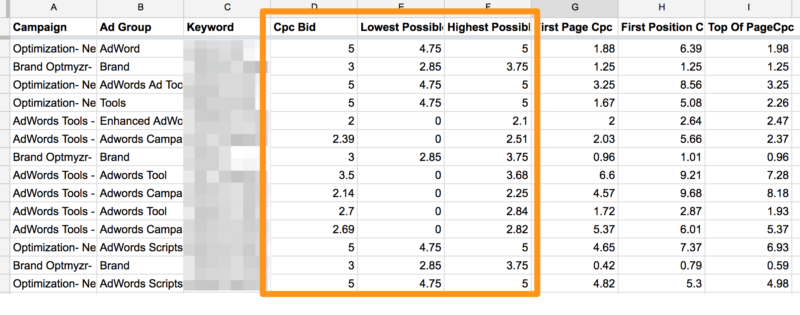Do you really know how much you’re bidding?
Columnist Frederick Vallaeys shares a handy AdWords script that generates a spreadsheet of your base bids with the actual min and max possible values based on your various bid modifiers.
We’ve all read stories about the most expensive CPCs in AdWords — and while we may find these high CPCs surprising, I bet most of us don’t truly know how much we are bidding for our own keywords.
How is that possible, you ask? As bid management has become more complex over the years, it’s very easy to lose sight of the final CPC that’s hidden behind layers of bid modifiers that are stacked on top of the base bid.
The evolution of PPC bid management
While I won’t say bid management was ever simple, there was a time when things were much more transparent. In the days of GoTo and Overture, bids were so transparent that bid jamming was a common practice; companies would bid a penny less than the max bid of their competitors to force them to pay the highest possible price.
Then along came Google AdWords, where the final CPC became dependent on the Quality Score. While you could still see your max CPC, the bid that was used in the auction became impossible to know.
Despite this opaqueness, the bids were still easy to see because every keyword had a max CPC, and that was the end of it. If you wanted to bid more in different regions, you’d simply create a mirror campaign with different bids. It was easy to look at the CPC column next to a keyword to instantly figure out how high a bid was.
With the introduction of bid adjustments, things got way more complicated. When using bid modifiers, the maximum CPC is just a starting point, and the actual bid is the result of multiplying that bid with all the applicable bid modifiers.
Because AdWords doesn’t show us what those modifiers are on the same page where we see keyword bids, there’s no easy way to quickly see how much we’re willing to spend for a keyword.
So this month, I’d like to share an AdWords reporting script that will give you instant clarity about your bid ranges. Using AdWords scripts, we can look up the highest and lowest bid modifiers in effect for dayparts and geographies in each campaign. We can also find the mobile bid adjustments for each ad group.
Unfortunately, scripts don’t have access to audience bid modifiers, so if you’re using those (and you probably should), then just keep that in mind as you review the data.
An AdWords script to see CPC ranges for each keyword
Grab a copy of the script here, paste it into an AdWords account, and preview it:
The output will be a spreadsheet with two tabs. The first tab, called “Campaigns,” shows the highest and lowest bid modifier for mobile, geographies and dayparts for each active campaign. (Note that it won’t include Shopping campaigns or YouTube campaigns.)

See the highest and lowest bid modifiers for all of your AdWords campaigns on a single spreadsheet.
The second tab, called “Keywords,” shows each keyword with the base CPC and the highest and possible CPCs based on campaign and ad group level bid modifiers. It also includes the estimated CPCs from Google showing at the top of the page, above the organic results, or on the first page of search results.

See your actual maximum and minimum CPC based on the combination of the base bid and all the available bid modifiers.
First page bid
Now that you can easily see the CPC ranges for all your keywords, it’s interesting to see how these compare to the AdWords columns “First Page Bid Estimate,” “First Position Estimate” and “Top of Page Bid Estimate.”
Now that you can see these estimates in context of what you’re really bidding, it may explain why you don’t show in your target positions as often as you were hoping. Just looking at the base CPC turns out to be pretty meaningless when trying to figure out if your bids are adequate to hit the desired positions on the page.

First page bid estimates carry a lot more meaning when you can see them in context of the full range of CPCs your keywords are bidding based on bid modifiers.
Coming soon: more device bid adjustments
Bid management will soon gain another layer of control (and complexity) when the recently announced device modifiers arrive. Today, we can only set a bid modifier for high-end mobile devices — but soon, we will also be able to set modifiers for “computers” and “tablets,” the two other segments of devices.
When that day arrives, this script will need to be updated to reflect these two additional levels of bid modification. I’ll probably post that update on the Optmyzr blog, but if you’ve been meaning to learn how to write scripts, this might be a good exercise to try out for yourself.
Make sure your base CPC is calculated using the right device data
The introduction of the new device bid modifiers got me and my team at Optmyzr thinking about how bid management could work in this day and age. We’ve been trained by Google to think in terms of a base bid (for computers) and use a dial for mobile bid adjustments to ensure we’re hitting our targets on all devices.
In this method, the correct CPC is calculated using only data from when the search happens on a desktop device (Computers). Then, the correct bids for mobile devices are calculated separately by determining by what percentage they should differ from the max CPCs we calculated for computers.
Review to see if you’re doing this right, because if you’re calculating your base bids using data from all devices and then applying an additional mobile bid modifier, you’re probably setting the wrong bids.
Choosing the device to which we anchor base CPCs
Google said that when the new device bid modifiers arrive, we’ll be able to choose on which device to anchor our bids. For example, we could set our base bids from mobile data and then use modifiers for “computers” and “tablets” to ensure those segments also perform well.
This bid management model assumes that, by and large, there will be a consistent difference in performance between the devices. For example, if tablets always convert worse than mobile, we might set a -30-percent modifier. When we go and calculate new base-level bids using the most recent data, we’re setting new bids for our anchor device type — in this example, mobile. Tablet bids then automatically change at the same time while remaining 30 percent lower than the base bid (because that’s the bid modifier we set).
This makes bid management tricky, because any change in bids cascades down to other devices, and we really should recalculate bid modifiers right afterward so that we’re using tablet data to decide if that -30-percent adjustment still makes sense considering the new base bid derived from data for another device type.
Should we rethink how we manage bids?
So we started thinking about a different way to handle bids. What if the keyword CPC was basically a placeholder value that we would almost never change? We could then use device bid modifiers to pull that base bid up or down to the actual CPC we want.
The benefit of this is that to change the mobile bid, you’d update the mobile bid modifier and it would not impact the other devices’ bids. Of course, the downside is that since device bid modifiers can only go down to the ad group level, you’d have to bid the same amount for all keywords in an ad group, and that’s usually a bad thing… unless you have single keyword ad groups.
There are definite pros and cons to both methods, but what I hope you take away from this is an appreciation for how complicated bid management has become and some of the things to remember when updating your own bids.
Conclusion
Even the simplest form of PPC bid management nowadays has a lot of complexity due to all the available bid modifiers. With the upcoming availability of several new layers of bid modifiers for devices and demographics, this is a great time to review how much you’re really bidding and if there are new and better ways to start managing your bids. I hope my script proves useful in getting you some interesting data to foster a conversation about bid management on your team.
Contributing authors are invited to create content for Search Engine Land and are chosen for their expertise and contribution to the search community. Our contributors work under the oversight of the editorial staff and contributions are checked for quality and relevance to our readers. The opinions they express are their own.
Related stories
